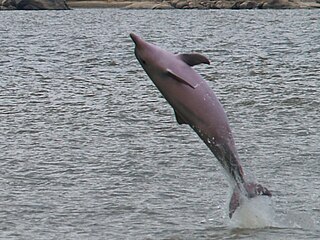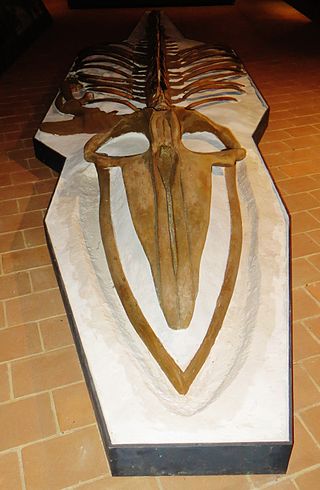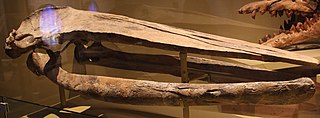
Tube-dwelling anemones or ceriantharians look very similar to sea anemones but belong to an entirely different class of anthozoans. They are solitary, living buried in soft sediments. Tube anemones live inside and can withdraw into tubes, which are composed of a fibrous material made from secreted mucus and threads of nematocyst-like organelles known as ptychocysts. Within the tubes of these ceriantharians, more than one polyp is present, which is an exceptional trait because species that create tube systems usually contain only one polyp per tube. Ceriantharians were formerly classified in the taxon Ceriantipatharia along with the black corals but have since been moved to their own class, Ceriantharia.

Eurhinodelphis is an extinct genus of Miocene cetacean. Its fossils have been found in Belgium, France, and Maryland.

Diomedeoides is a prehistoric genus of seabirds. The family was in the order Procellariiformes which today is composed of the albatrosses and petrels. At present it is the only genus in the family Diomedeoididae. There are three described species. The taxonomy of the family and genus is still in need to revision, and it is likely that the genus name Diomedeoides is actually the junior synonym to Rupelornis.

The dolphin genus Sotalia is considered to have two member species with the classification of Sotalia guianensis as a distinct species from Sotalia fluviatilis in 2007. This was a result of recent morphometric analyses, as well as mitochondrial DNA analysis.
Diunatans is an extinct genus of rorqual. It lived in the North Sea during the Early Pliocene. Two specimens have been found from the Netherlands. They were collected from the Kattendijk Formation in the province of Zeeland, which is Zanclean in age. Diunatans is considered to be a stem balaenopterid because it falls outside the Balaenoptera+Megaptera clade, which includes all living rorquals.

Protororqualus is a genus of extinct rorqual from the late Pliocene of Mount Pulgnasco, Italy.
Plesiocetus is a genus of extinct balaenopterids found worldwide. It has had a chequered taxonomic history, having served as a wastebasket genus for a handful of mysticete species.

Cetotheriopsis is a genus of extinct cetaceans of the family Cetotheriopsidae.
Monotherium is an extinct genus of phocid belonging to the subfamily Monachinae. It is known from fossils found in the middle to late Miocene of Belgium.

Aglaocetus is a genus of extinct baleen whales known from the Miocene of Patagonia, the US Eastern Seaboard, Japan and the Low Countries. It was once considered a member of Cetotheriidae along with many other putative cetotheres, but was recently recognized as representing a distinct family from true Cetotheriidae.
Nanophoca is an extinct genus of earless seals from the middle Miocene of Belgium.
Phocanella is an extinct genus of earless seals from the early Pliocene of Belgium and the US Eastern Seaboard.
Platyphoca is an extinct genus of earless seals from Neogene marine deposits in the North Sea basin.
Beneziphius is an extinct genus of ziphiid cetacean known from late Miocene to Pliocene marine deposits in Belgium and fishing grounds off Spain. The genus name honors Pierre-Joseph van Beneden, who pioneered the study of Neogene marine mammals from Belgium.
Frisiphoca is an extinct genus of phocid belonging to the subfamily Phocinae. It is known from fossils found in the late Miocene of Belgium.

Calliobdella is a genus of annelids belonging to the family Piscicolidae.
Hensenanthula is a genus of cnidarians belonging to the family Botrucnidiferidae.
Botrucnidiferidae is a family of cnidarians belonging to the order Spirularia.
Gastrocotyle is a genus of flatworms belonging to the family Gastrocotylidae.








